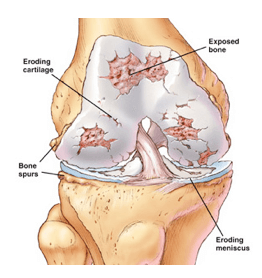Arthritis
Arthritis is a condition characterized by joint inflammation. This disease can affect one joint or multiple joints. The two most common kinds of arthritis are osteoarthritis (OA) and rheumatoid arthritis (RA), but there are over 100 different types. Arthritis usually affects people age 65 years and older, but it can occur at any age.
Who gets arthritis?

Arthritis tends to affect women slightly more often than men. Based on the National Health Interview Survey (NHIS) from the National Center for Health Statistics, arthritis affects around 25% of adults age 18 years and older. Around 25 million Americans also report arthritis-attributable limitations of activity.
How common is arthritis?
By the age of 85 years, 50% of people develop OA of the knee. In addition, 25% of people have hip arthritis by age 80 years old. As many as 42 million U.S. adults have some form of arthritis, as well as 300,000 children under age 18 years.
What causes arthritis?
Cartilage is a flexible tissue in the joints that absorbs pressure and shock when you put stress on the joint or move. Any reduction in this connective tissue amount can lead to some form of arthritis. Arthritis is caused by:
- Wear-and-tear – This occurs from normal activities.
- Infection or injury – This can exacerbate the breakdown of cartilage tissue.
- Family history – Your risk for arthritis is higher if you have a family history of the condition.
- Autoimmune problems – RA is caused by an autoimmune disorder where the body’s immune system attacks the body’s tissues. This breaks down the synovium, which is soft tissue in the joints that produces fluid to lubricate and cushion the joints.
What are the symptoms of arthritis?
The symptoms of arthritis depend on the type of condition. Common symptoms include joint pain, swelling, and stiffness. Many patients also have a decreased range of motion and redness of the skin at the site of the joint. With RA, the symptoms also include joint deformities, loss of appetite, fatigue, and anemia.
How is arthritis diagnosed?
Diagnosis of arthritis begins with a medical history and physical examination. During the exam, the doctor checks your joints for warmth, fluid, and range of motion. The doctor may need to extract and analyze your joint fluid and blood to determine the type of arthritis you have. Many imaging scans are used to diagnose arthritis, which include x-rays, computed tomography (CT) scans, and magnetic resonance imaging (MRI) scans.
How is arthritis treated?
The main goal of treatment is to alleviate pain, improve joint function, and prevent further joint damage. Treatment options include:
- Oral medications – For pain management, analgesics are used (hydrocodone and tramadol), as well as nonsteroidal anti-inflammatory drugs (NSAIDs).
- Topical medications – These include menthol and capsaicin creams that block the transmission of pain signals from the joints.
- Disease-modifying anti-rheumatic drugs (DMARDs) – These are immune system suppressants.
- Corticosteroids – For short-term, potent anti-inflammatories are used, such as prednisone and injectable cortisone.
- Physical therapy – This involves exercises to strengthen the muscles around the affected joint(s), as well as pain relief measures (electrical stimulation, ultrasound, and heat therapy).
- Regular exercise – To improve joint flexibility, the doctor will recommend that you get some type of exercise. Swimming and stationary cycling are two methods of activity that do not require weight-bearing.
- Surgery – For severe arthritis, the affected joint can be fused. In addition, a total joint replacement may be necessary.
- Facet joint injections (FJIs) The facet joints are small joints on each side of the posterior vertebrae. FJIs involve injecting these tiny joints with a corticosteroid agent, with or without an anesthetic. The success rate for this procedure is around 77%, according to recent studies.
- Epidural steroid injection (ESI) – For back pain related to arthritis, and ESI involves injecting the epidural space with a long-acting corticosteroid agent. This procedure is quite effective, with research trials showing an 85-90% efficacy rate.
- Neurotomy – For sacroiliac joint arthritis and spinal arthritis, the pain doctor in Chicago can use radiofrequency energy to destroy a portion of the affected nerve root. This involves insertion of small needles into the spine and positioning them near the nerves. The electric current is projected onto the nerves via a needle. In a recent clinical study, 91% of patients reported successful pain relief. Additionally, more than half of study participants reported pain relief that lasted for more than 3 months.
- Neurotomy – For spinal arthritis and sacroiliac joint arthritis, the Chicago pain management doctor can use radiofrequency energy to generate heat, which eliminates a portion of the nerve root. Neurotomy involves inserting small needles into the skin above the spine. A special needle probe is inserted near the nerves, and the electric current is used to destroy the nerves.
Arthritis Treatment in Chicago
Take the first step towards a pain-free life by scheduling your appointment with Premier Pain & Spine today!
